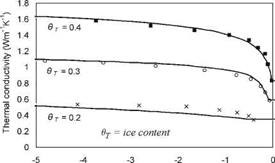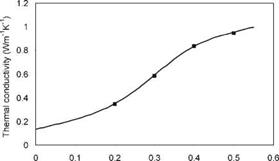Thermal Capacity, c
Thermal capacity characterises the ability of a material to store or release heat. It is the important property that relates to the delay in heat transfer. The thermal capacity of water is approximately twice as high as that for most minerals and for ice, while the thermal capacity of air is negligible.
|
Temperature (°С) |
|
Volumetric water content, в Fig. 4.2 Typical relationships between thermal conductivity and ice content (top) and between thermal conductivity and water content (bottom) (Hansson et al., 2004). Credit: the Vadose Zone Journal, published by the Soil Science Society of America |
The thermal capacity of saturated soils ranges between 800 and 1000 J/(kg°C) – that is between 2000 and 2400 J/(m3°C) – while dry soils exhibit values of between 300 and 1600 J/(m3°C).








Leave a reply